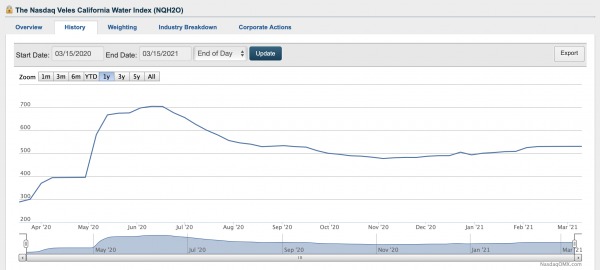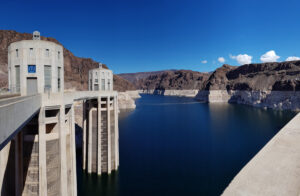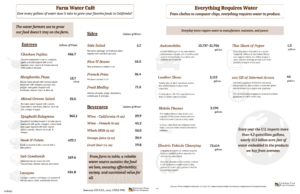Much has been written lately about a new water futures contract market that provides a way for individuals to profit (or lose) off of fluctuating water prices in California. Based on the Nasdaq Veles Water Index (Index), buyers and sellers are able to speculate on the future price of water to either hedge against price changes if you’re a water user, or profit off of price changes if you’re a speculator who has no other interest than making money.
Adding to the confusion is the interchanged use of the terms “water futures,” “water market,” and “water transfers.”
“Water futures” are contracts that allow a buyer to try and outguess what the future price of water will be and turn a profit if they’re right. The participants in water futures contract trading understand that tangible water will not be delivered as part of the agreements.
“Water markets” are a collection of commercial activities where actual water is bought and sold and is, by and large, regulated by the State Water Board.
“Water transfers,” also regulated by the State Water Board, provide a mechanism to balance water needs within a region or between regions, and have helped increase the flexibility of California’s water system.
Water Transfers vs Water Markets vs Water Futures Trading: On-Farm
There is a clear distinction between water transfers between willing sellers and willing buyers and water markets. Water markets, similar to water futures contracts, are often associated with third parties’ (which could be in other states or even countries) speculation on water pricing without actively engaging in the management/movement of water.
Farmers are often cited as potential beneficiaries of water futures trading because rising water prices can affect the bottom line when they’re irrigating a crop. But are farmers actually going to use this tool to help manage water costs? That remains uncertain.
The Water Futures Index
The Nasdaq Veles Water Index is based on the prices of actual historical water trades in California that include, essentially, State Water Project (SWP) and Central Valley Project (CVP) transactions, as well as sales within four Southern California adjudicated water basins: the Central Basin, the Chino Basin, the Main San Gabriel Basin, and the Mojave Basin Alto Subarea.
Contracts are sold in 10-acre-foot blocks. The index price as of March 9, 2021 for water contracts ending in June of 2021 was $597 per acre-foot. The June 2022 index price was $603, a difference of just $6 per acre-foot, however that could change significantly if water supply conditions change down the road, like if we enter another period of extended drought.

For example, from March 2020 to June 2020 the index price increased from a little over $200 per acre-foot to roughly $700/ af. It has since fallen back to the sub $600 range, and again, is based on prior actual water sales for both agricultural and urban supplies.
Contracts are available for up to two years in length and are typically settled quarterly on the third Wednesday of the month.
Terms usually end in March, June, September, or December and while they have a set period, contracts can be traded at any time throughout their term.
Someone buying into the water futures market is not buying actual water. Instead, they are attempting to guess where water prices will be in the future. If you buy a June 2022 water futures contract at today’s price of $603, you’re hoping that the index price when the contract is sold is higher than $603. If the price declines, you’ll sell the contract at a loss.
In the practical sense, how would a water futures contract benefit a farmer? Most of the published examples go something like this:
A farmer buys five contracts (50 acre-feet total) at $600 per acre foot for a cost of $30,000. Under the assumption that the index price of water rises to $800, the farmer is set to make $200 per acre-foot X 50 acre-feet for a total profit of $10,000. That profit could then be used to buy water at the actual price when it is needed for the irrigation season.
The reality is, during a shortage, local agricultural water prices could easily be $400 an acre-foot. When the farmer actually needs water, the $10,000 profit from the index transaction, at $400 per acre-foot, would buy 25 acre-feet of water, enough to irrigate about 10 acres of tomatoes or roughly 7 acres of almonds. The same amount of water could be enough to supplement 25 existing acres of production with an extra one acre-foot per acre. Thinking bigger, under this same scenario, water futures contracts intended to supplement 250 acres of farmland would cost $300,000 up front and there is no guarantee of a profitable return.
The Index also provides a mechanism for purchases on a 10% margin, meaning the up-front investment could be considerably less, $30,000 in the prior example. However, the risk is considerably more if cash reserves aren’t available when the contract matures and prices have declined. That kind of risk led to a few people jumping from buildings after “margin calls” during the stock market crash in 1929.

It is hard to imagine water futures operating at a scale that actually works for agriculture. Perhaps protecting a high-value crop with supplemental water (if it’s available) is worth the high price of purchasing one or more water futures contracts. But farmers are risk-aware by nature. Is it reasonable to think they’re likely going to gamble a lot of up-front capital under the assumption that water prices will rise?
The Magic 8 Ball would likely say, “Don’t count on it.”


